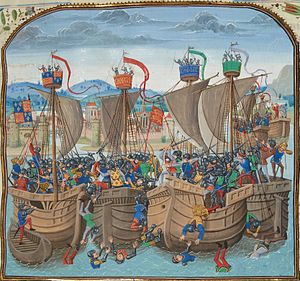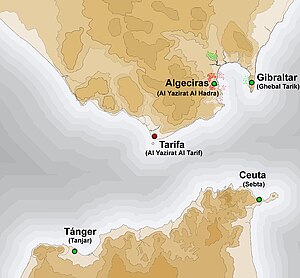Egidio Boccanegra
Egidio "Gil" Boccanegra (called black beard , * 13th or 14th century, † 1367 in Seville by execution ), was a Genoese admiral and corsair under King Philip VI. from France. He fought in the Hundred Years War and took part in the Spanish Reconquista .
family
Boccanegra was born into a wealthy middle-class family, descended from Guglielmo Boccanegra, who was appointed Genoese magistrate in 1257 . He was a lawyer and officer in the Navy and was the first to hold the post of Capitano del Popolo .
The first Doge of Genoa, Simone Boccanegra, was a brother of Egidio. Its importance can be seen in the novella by Antonio García Gutiérrez and the opera Simon Boccanegra by Giuseppe Verdi .
Naval Battle of Sluis
1340 Egidio was from King Philip VI. enlisted by France to work together with the French fleet against the overwhelming English fleet under Edward III. proceed. The Genoese handed over a large number of ships with bow and crossbowmen from his city to the French commanders.
On the evening of June 23rd, the united French-Genoese fleet met in the naval battle of Sluis on the English enemy under the personal leadership of the English king, which had left England the day before. The French armed forces were almost completely destroyed after a day of fierce fighting, 30,000 men lost their lives, including the prisoners who were also killed after the battle.
Egidio Boccanegra intended to maneuver the French fleet out of the bay in which it was trapped. The French captains, however, refused to follow his advice and were all killed in time. Boccanegra, however, managed to escape. He took along two English ships that he had captured.
Admiral of Castile
After the devastating defeat of the Castile fleet against the Merinids, who came from North Africa, in the Battle of Getares in 1340, the Castile fleet was in ruins. That is why Alfonso XI asked the Kingdom of Portugal and the Kingdom of Aragon for help. They agreed to help because they feared an invasion of North Africa, just as they had earlier in the Iberian Peninsula . In addition, Alfonso XI asked the Republic of Genoa to help rebuild the Castile fleet. He explicitly asked for the help of Egidio Boccanegra, who was already known as a capable fleet commander, and promised to appoint him admiral if he was sent to him. Genoa also agreed and sent Egidio Boccanegra and 12 galleys to help the Kingdom of Castile rebuild the Castilian navy to face the threat to the Merinids.
He arrived in Castile in 1341 and Alfonso XI immediately appointed him admiral, as promised. He became the 18th admiral of the Castilian fleet. He got to work immediately and with the help of the Portuguese he was finally able to defeat the Merinids in two naval battles in 1342. For his victories he got the lands in Palma del Río in 1342. Boccanegra also took part in the following siege of Algeciras in the same year, under the command of Alfonso XI, which was made possible by these victories and a third victory of the Aragonese fleet. He was able to successfully maintain the siege at sea, while Alfonso XI was also able to successfully carry out the siege on land. It therefore ended in 1344 with the capture of Algeciras by Castile, which finally ended the threat from the Merinids.
In recognition of his services, his son Ambrosio Boccanegra received several houses in Seville and Algeciras. In addition, Admiral Boccanegra gained international fame through his military successes at sea in these battles. Even the Kingdom of England wanted to hire him for their navy that same year, but he turned down their offer and decided to stay in Castile. In addition, he organized and directed the unsuccessful siege of Gibraltar in 1349 on the instructions of Alfonso XI , which was ended because of the death of Alfonso XI during the siege due to the plague in 1350. After the death of Alfonso XI, his successor Peter I of Castile confirmed him in his office.
In 1357 he took part in the First Castilian Civil War in the Battle of Trigueros against Juan de la Cerda , a supporter of Henry II, on the side of Peter I of Castile . During the two Peter War , which took place in parallel with the Civil War, he led the Castilian fleet command Peters I unsuccessfully against Barcelona . Even so, it could be considered a success because for the first time the Castilian Navy was able to carry out such an operation so far from Castile. He later changed sides in the First Castilian Civil War in 1366 and became part of Henry II of Trastámara . As such, he hijacked the ship with the royal treasure for Henry, which Peter I wanted to transport by sea to Portugal when Henry took control of Castile that year. For his participation in the rebellion, Egidio Boccanegra was therefore executed in Seville in 1367, when Peter I took control of the Kingdom of Castile again that year.
Several sons and daughters emerged from his marriage to María Piesco, including Ambrosio Boccanegra , who succeeded his father in the Castilian fleet after Henry II finally took over power.
See also
bibliography
- CALDERON ORTEGA, JM y DÍAZ GONZÁLEZ F .: “Los Almirantes del siglo de oro de la marina castellana medieval”. Revista en la España Medieval Nº 24 (2011) pp. 311-364. (Spanish) .
- FERNÁNDEZ DURO, CESAREO (1894). The marina de Castilla desde su origen y pugna con la de Inglaterra hasta la refundición en la Armada española. Madrid. (Spanish) .
Remarks
- ↑ Fernández Duro p. 86
- ↑ III. LOS ALMIRANTES DE CASTILLA, SIGNIFICADOS PERSONALES DE SU ÉPOCA, SIGLOS XIII-XV pp.12-13 Los almirantes de Castilla: Descripción Historica Institucional —SIGLOS XIII XVI - Retrieved September 18, 2018. (Spanish) .
- ↑ Ortega y González p. 328
- ↑ Ortega y González p. 333
- ↑ Ortega y González pp. 334-336
- ↑ Ortega y González p. 337
| personal data | |
|---|---|
| SURNAME | Boccanegra, Egidio |
| ALTERNATIVE NAMES | Gil Boccanegra (nickname); Black beard |
| BRIEF DESCRIPTION | Genoese admiral and corsair |
| DATE OF BIRTH | 13th century or 14th century |
| DATE OF DEATH | 1367 |
| Place of death | Seville |

